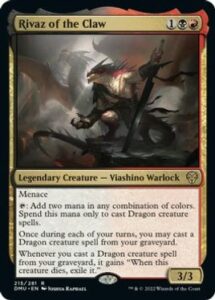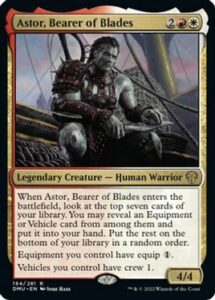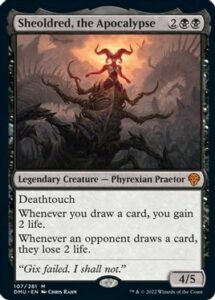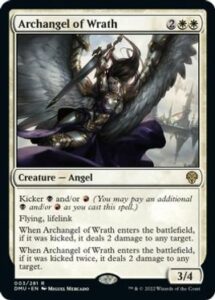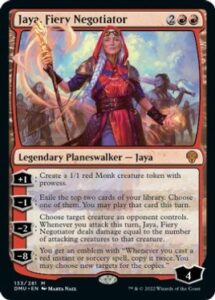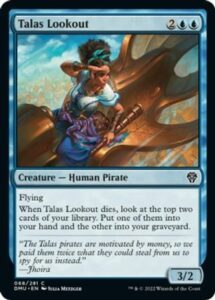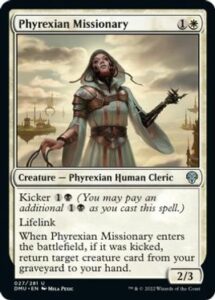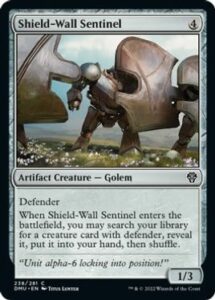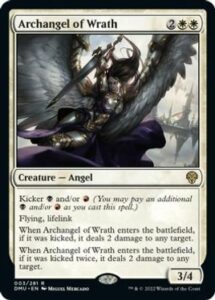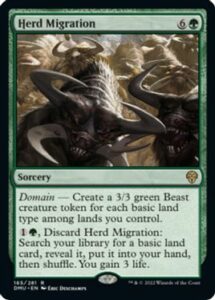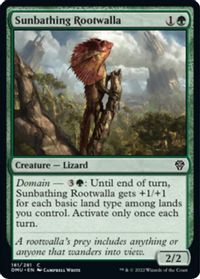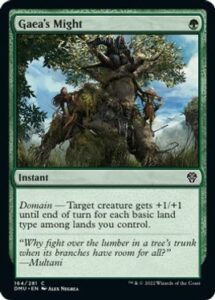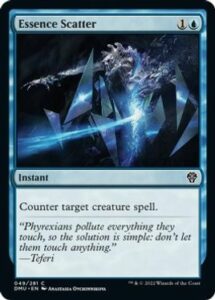Dominaria United Limited

This past week I spent a good amount of time drafting. In fact, I did about 50 drafts of Dominaria United.
At first I was enamored with kicker, domain, and the sweet dual lands that count for domain. The format appeared to have tons of depth because of this. You can play any colors, and you can find different ways to abuse Domain.
In the end, the formats fell a little flat to me. It’s scaled back the power level of cards for Limited. The uncommon gold cards don’t tell much of a story as a guidepost for what you should be doing, rather than being just generically solid creatures for the most part. And yes, they’re all creatures. There aren’t cool gold spells that do anything fun. It’s a legendary creature set without rhyme or reason for there to be a bunch of legendary creatures. There’s no Cast Down nor Historic triggers.

Rare slots are glutted with Lords that are mostly unsupported in Limited, outside of Soldiers for which there are an abundance of token makers. There are also pain lands at rare, which are often worse in Limited than their common counterpart since they don’t account for domain, an important mechanic in this format.
My least favorite of the bunch are rares like Jhoira, Ageless Innovator, Zur, Eternal Schemer, Rivaz of the Claw, Meria, Scholar of Antiquity, Astor Bearer of Blades. All of these gold legends should feel great to put in your decks, but they’re mostly plain-text, common-rate creatures that you can pick up on the wheel for free and plug into your decks if you need a playable.
The format is still fun, and I think the strength of this format is in the gameplay. While colors are somewhat balanced, I find that spending mana efficiently is how I’m winning. It feels hard to lose when you’re spending your mana well every turn and progressing your board. Combat is also important, such as finding ways to make quality blocks and set up counterattacks if you’re on the defensive or finding ways to break the opponent board stall.
Games are rarely one-sided affairs because of the underwhelming amount of lopsided rares. I can’t think of any rares that are impossible to beat with just some commons and uncommons. Cards like Sheoldred, Archangel of Wrath, and Jaya are all easily answered by tons of common removal, like Extinguish the Light and Citizen’s Arrest.
Initially, I was struggling with the format by trying to go too deep on colors and fixing. I found myself with shaky mana bases in more powerful decks and had to find the sweet spot. Eventually, I decided to stick to more two- and three-color decks rather than try and fit GW and UB Legendary creatures into my deck, and it worked out. Instead of 2-1ing a lot, I started to get the trophies and racked up 25 trophies in between 50 and 60 attempts on MTGO, and I currently sit as the trophy leader at the time of writing this, which is no big deal.
The format speed is fairly slow


The format speed is fairly slow, but there can be some fast games. UR Tempo and WR Tokens can close games out in a hurry. This is where it’s important to make sure you’re playing to the board and able to provide a clock and not folding to a combat trick or two in the late game. UR does it in more of a Tempo-with-unblockable-creatures way, and WR will do it with going wide and using Inspired Charge to cheese you out.
The format’s combat tricks are all playable in some regard. They’re a little better than normal formats and provide tons of valuable abilities, most of which include indestructible to ensure you win combats. They’re not premium because it’s hard for combat tricks to be the best thing going on in a format with so much value. However, they still set up massive attacks and fight through walls and Tolarian Terror when necessary.
As far as slower decks, it’s important your deck can grind with the slower decks or get under them. Raw card draw isn’t as good as it used to be, so while cards like Phyrexian Espionage and Shadow Prophecy are fine and quite solid, you want card advantage on bodies. Cards like Phyrexian Rager and Talas Lookout are better sources of picking up an extra card.
White gets Phyrexian Missionary at uncommon to generate more cards, and green gets Vineshapre Prodigy if you can kick these cards, which is easy to find a land or two to fuel them amongst other fixers.
White gets one of the more controversial cards I’ve ever seen in Limited. Wingmantle Chaplain is a powerhouse of an uncommon that can have a few effects on your draft. You can high roll and get a couple of Shield-Wall Sentinel amongst other uncommon defender payoffs of other colors. You can also get only one Sentinel and maybe two or three common walls and have a smaller defender package.
It feels impossible to lose when your Wingmantle is doing its thing. There are few decks that can keep up with it once it starts rolling, especially if you’re able to rebuy the wall with gravedigger effects, like Phyrexian Missionary. If you’re able to get multiple Wingmantle Chaplains, then those wins feel very free. The decks that can overpower it are doing their thing faster, like UR Tempo or WR go wide with a quick Inspired Charge kill.
That said, you can sink your draft by going down the defender, taking cards that are otherwise kind of useless, and not getting there. Sometimes the Chaplain doesn’t even make your deck. You spent your draft setting it up, failed to get there, and the result is some mess of cards that barely functions. This is the risk of ruin that moving into the defender archetype comes with, and while I’d say it’s not uncommon that this happens, it’s not common either.
I’ll still be first-picking Wingmantle Chaplain until people show me why I shouldn’t. I’d still take some of the best rares like Sheoldred, Archangel of Wrath, and Herd Migration over it, but I’m not first-picking uncommons or commons over it, as it’s too powerful, and the power level of the format is too flat. Wingmantle is one of the only snowballing cards in the format, so it’s unique and powerful enough that you shouldn’t just ignore it, but it’s also not powerful enough to fight another player for. So proceed with caution.
In a format where the lands are so important, you need…
In a format where the lands are so important, you need to take them early and have a plan for what you’re doing. Understand what lands open up what options for you later in the draft. Green lands are a little more valuable than others because they get played in mana cases when you’re not even using the other color, just to make your domain cards like Sunbathing Rootwalla and Gaea’s Might.
In pack one you’re forced with some tough decisions at times, and in general I like taking the lands earlier and letting the lands dictate how flexible I can be. The power level of the format is pretty flat, and the lands are the things I struggle to get the most. Lots of my decks end up with tough cuts at spells while I’m wishing I picked up that extra land pack one that seemed fine to pass on.
The format feels a lot like the original Invasion. It’s a lot of back and forth and finding open colors and playing well has been the most important thing for me. The cards don’t get to win the games for you, so you need to work for it by learning the combat tricks, the play patterns, and what matters. I’ve learned to understand that getting the most out of my mana is as important as getting the most out of my cards. This means foregoing kicker on things in situations where I have other things to spend mana on.


The more I play, the more I win, which isn’t always the case in Limited. Generally, I’m a fast learner and come out blazing. After a week, people catch up, but this format has so little variety that almost everything feels telegraphed to me, and I can make plays around what the opponent is doing. “Oh, they have Gaea’s Might,” “They’re holding up Essence Scatter,” “They’re trying to use Inspiring Charge against me in this game.” These are things I say out loud by the mid-game, which helps me dictate my plays on the turns I recognize it and beyond.
While there are a few tricks up my sleeve for Worlds, the format tends to reward good Limited fundamentals and playing a lot will get you to a good spot. If you don’t play a lot, then the format is fun enough, but it can get stale since the same cards seem to show up every game, and eventually you get tired of repeatedly seeing the same cards.
I’d recommend the format for a bit, but don’t plan on falling in love and drafting it for months, as I think you’ll be disappointed. I hope they revisit a format with both domain and kicker because it is a setup for what could be the most fun Limited format of all time, however I think they missed the mark this time.
Let me know what you think about this format. I’m curious to hear how people are liking it.
Until next week!







